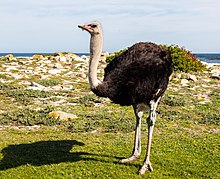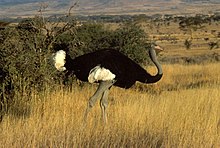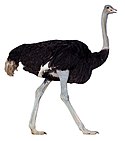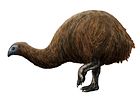Struthionidae
| Struthionidae Temporal range: Miocene-Holocene Possible Paleogene taxa.
| |
|---|---|

| |
| Struthio camelus australis at the Cape of Good Hope, South Africa | |
| Scientific classification | |
| Kingdom: | Animalia |
| Phylum: | Chordata |
| Class: | Aves |
| Infraclass: | Palaeognathae |
| Order: | Struthioniformes Latham, 1790 |
| Family: | Struthionidae Vigors, 1825[1] |
| Type species | |
| Struthio camelus Linnaeus, 1758
| |
| Genera | |
| |
| Synonyms[2][3] | |
| |
Struthionidae (/ˌstruːθiˈɒnədiː/; from Latin strūthiō 'ostrich', and Ancient Greek εἶδος (eîdos) 'appearance, resemblance') is a family of flightless birds, containing the extant ostriches and their extinct relatives. The two extant species of ostrich are the common ostrich and Somali ostrich, both in the genus Struthio, which also contains several species known from Holocene fossils such as the Asian ostrich. The common ostrich is the more widespread of the two living species, and is the largest living bird species. Other ostriches are also among the largest bird species ever.
The first species of Struthio appear during the Miocene epoch, though various Paleocene, Eocene, and Oligocene fossils may also belong to the family.[4][5] Ostriches are classified in the ratite group of birds, all extant species of which are flightless, including the kiwis, emus, and rheas. Traditionally, the order Struthioniformes contained all the ratites. However, recent genetic analysis has found that the group is not monophyletic, as it is paraphyletic with respect to the tinamous, so the ostriches are usually classified as the only members of the order,[6][7] though the IUCN uses a broader classification and includes all "ratites" and tinamous in Struthioniformes.[8]
Evolution[]
The earliest fossils of ostrich-like birds are Paleocene taxa from Europe.[9] Palaeotis and Remiornis from the Middle Eocene and unspecified ratite remains are known from the Eocene and Oligocene of Europe and Africa. These may have been early relatives of the ostriches, but their status is questionable, and they may in fact represent multiple lineages of flightless paleognaths.[9][5] The African Eremopezus, when not considered a basal secretarybird or shoebill, is sometimes considered an ostrich relative or an "aepyornithid-like" taxon.[5] Apart from these enigmatic birds, the fossil record of the ostriches continues with several species of the modern genus Struthio, which are known from the Early Miocene onwards. Several of these fossil forms are ichnotaxa (that is, classified according to the organism's footprints or other trace rather than its body) and their association with those described from distinctive bones is contentious and in need of revision pending more good material.[10]

While the relationship of the African fossil species is comparatively straightforward, many Asian species of ostriches have been described from fragmentary remains, and their interrelationships and how they relate to the African ostriches are confusing. In China, ostriches are known to have become extinct only around or even after the end of the last ice age; images of ostriches have been found there on prehistoric pottery and petroglyphs.[11][12][13] Ostriches have co-existed with another lineage of flightless didactyl birds, the eogruids. Though Olson 1985 classified these birds as stem-ostriches, they are otherwise universally considered to be related to cranes, any similarities being the result of convergent evolution. Competition from ostriches has been suggested to have caused the extinction of the eogruids,[14][15] though this has never been tested and both groups do co-exist in some sites.[16]
As with most other ratites, ostriches are believed to have developed flightlessness in the wake of the Cretaceous-Paleogene extinction event of about 66 Ma.[17][18] The sudden absence of non-avian dinosaurs opened ecological niche space for large herbivorous animals and limited predatory threats, prompting volant ancestral paleognaths dispersed across the southern hemisphere to convergently lose the capability for flight.[18][19][20]
Distribution and habitat[]

Today ostriches are only found natively in the wild in Africa, where they occur in a range of open arid and semi-arid habitats such as savannas and the Sahel, both north and south of the equatorial forest zone.[21] The Somali ostrich occurs in the Horn of Africa, having evolved isolated from the common ostrich by the geographic barrier of the East African Rift. In some areas, the common ostrich's Masai subspecies occurs alongside the Somali ostrich, but they are kept from interbreeding by behavioral and ecological differences.[22] The Arabian ostriches in Asia Minor and Arabia were hunted to extinction by the middle of the 20th century, and in Israel attempts to introduce North African ostriches to fill their ecological role have failed.[23] Escaped common ostriches in Australia have established feral populations.[24]
Taxonomy[]

In 2019, the species S. pannonicus, S. dmanisensis (the giant ostrich), and S. transcaucasicus were transferred to the genus Pachystruthio.[25]
Order Struthioniformes Latham 1790 (ostriches)
- Family Struthionidae Vigors 1825
- Genus ?†Remiornis Lemoine 1881
- Genus ?†Eremopezus Andrews 1904
- Genus †Palaeotis Lambrecht 1928 (middle Eocene)
- Genus †Orientornis Wang 2008
- Genus †Pachystruthio (Kretzoi 1954) (Late Pliocene – Pleistocene)
- Genus Struthio Linnaeus 1758 (Early Miocene – Recent)
See also[]
References[]
- ^ Brands, Sheila (14 Aug 2008). "Taxon: Genus Struthio". Project: The Taxonomicon. Retrieved 12 Jun 2012.
- ^ Haaramo, Mikko (2007). "Paleognathia - paleognathous modern birds". Mikko's Phylogeny Archive. Retrieved 30 December 2015.
{{cite web}}: External link in|publisher= - ^ Brodkob, Pierce (1963). "Catalogue of fossil birds 1- Archaeopterygiformes through Ardeiformes". Biological Sciences, Bulletin of the Florida State Museum. 7 (4): 180–293. Retrieved 30 December 2015.
- ^ Buffetaut, E.; Angst, D. (November 2014). "Stratigraphic distribution of large flightless birds in the Palaeogene of Europe and its palaeobiological and palaeogeographical implications". Earth-Science Reviews. 138: 394–408. doi:10.1016/j.earscirev.2014.07.001.
- ^ a b c Agnolin et al, Unexpected diversity of ratites (Aves, Palaeognathae) in the early Cenozoic of South America: palaeobiogeographical implications Article in Alcheringa An Australasian Journal of Palaeontology · July 2016 DOI: 10.1080/03115518.2016.1184898
- ^ Hackett, S.J. et al. (2008) A Phylogenomic Study of Birds Reveals Their Evolutionary History. Science, 320, 1763.
- ^ Yuri, T. (2013) Parsimony and model-based analyses of indels in avian nuclear genes reveal congruent and incongruent phylogenetic signals. Biology, 2:419–44.
- ^ "The IUCN Red List of Threatened Species". IUCN Red List of Threatened Species. Retrieved 2020-04-10.
- ^ a b Buffetaut, E.; Angst, D. (2014). "Stratigraphic distribution of large flightless birds in the Palaeogene of Europe and its palaeobiological and palaeogeographical implications". Earth-Science Reviews. 138: 394–408. doi:10.1016/j.earscirev.2014.07.001.
- ^ Bibi, Faysal; Shabel, Alan B.; Kraatz, Brian P.; Stidham, Thomas A. (2006). "New Fossil Ratite (Aves: Palaeognathae) Eggshell Discoveries from the Late Miocene Baynunah Foramation of the United Arab Emirates, Arabian Peninsula" (PDF). Palaeontologia Electronica. 9 (1): 2A. ISSN 1094-8074.
- ^ Doar, B.G. (2007) "Genitalia, Totems and Painted Pottery: New Ceramic Discoveries in Gansu and Surrounding Areas". China Heritage Quarterly
- ^ Janz, Lisa; et al. (2009). "Dating North Asian surface assemblages with ostrich eggshell: implications for palaeoecology and extirpation". Journal of Archaeological Science. 36 (9): 1982–1989. doi:10.1016/j.jas.2009.05.012.
- ^ Andersson, J. G. (1923). "Essays on the cenozoic of northern China". Memoirs of the Geological Survey of China (Peking), Series A. 3: 1–152 (53–77).
- ^ Kurochkin, E.N. (1976). "A survey of the Paleogene birds of Asia". Smithsonian Contributions to Paleobiology. 27: 75–86.
- ^ Kurochkin, E.N. (1981). "New representatives and evolution of two archaic gruiform families in Eurasia". Transactions of the Soviet-Mongolian Paleontologial Expedition. 15: 59–85.
- ^ Zelenkov, Nikita; Boev, Zlatozar; Lazaridis, Georgios (2015). "A large ergilornithine (Aves, Gruiformes) from the Late Miocene of the Balkan Peninsula". Paläontologische Zeitschrift. 90: 145–151. doi:10.1007/s12542-015-0279-z.
- ^ Feduccia, A. (1995-02-03). "Explosive Evolution in Tertiary Birds and Mammals". Science. 267 (5198): 637–638. doi:10.1126/science.267.5198.637. ISSN 0036-8075.
- ^ a b Mitchell, K. J.; Llamas, B.; Soubrier, J.; Rawlence, N. J.; Worthy, T. H.; Wood, J.; Lee, M. S. Y.; Cooper, A. (2014-05-22). "Ancient DNA reveals elephant birds and kiwi are sister taxa and clarifies ratite bird evolution". Science. 344 (6186): 898–900. doi:10.1126/science.1251981. hdl:2328/35953. ISSN 0036-8075.
- ^ Yonezawa, Takahiro; Segawa, Takahiro; Mori, Hiroshi; Campos, Paula F.; Hongoh, Yuichi; Endo, Hideki; Akiyoshi, Ayumi; Kohno, Naoki; Nishida, Shin; Wu, Jiaqi; Jin, Haofei (January 2017). "Phylogenomics and Morphology of Extinct Paleognaths Reveal the Origin and Evolution of the Ratites". Current Biology. 27 (1): 68–77. doi:10.1016/j.cub.2016.10.029. ISSN 0960-9822. PMID 27989673.
- ^ Phillips, Matthew J.; Gibb, Gillian C.; Crimp, Elizabeth A.; Penny, David (2009-11-13). "Tinamous and Moa Flock Together: Mitochondrial Genome Sequence Analysis Reveals Independent Losses of Flight among Ratites". Systematic Biology. 59 (1): 90–107. doi:10.1093/sysbio/syp079. ISSN 1076-836X. PMID 20525622.
- ^ Donegan, Keenan (2002). "Struthio camelus". Animal Diversity Web. University of Michigan Museum of Zoology.
- ^ Freitag, Stephanie & Robinson, Terence J. (1993). "Phylogeographic patterns in mitochondrial DNA of the Ostrich (Struthio camelus)" (PDF). The Auk. 110 (3): 614–622. doi:10.2307/4088425. JSTOR 4088425.
- ^ Rinat, Zafrir (25 December 2007). "The Bitter Fate of Ostriches in the Wild". Haaretz. Tel Aviv. Retrieved 10 January 2017.
- ^ Ostriches in Australia – and near my home. trevorsbirding.com (13 September 2007)
- ^ Zelenkov, N. V.; Lavrov, A. V.; Startsev, D. B.; Vislobokova, I. A.; Lopatin, A. V. (2019). "A giant early Pleistocene bird from eastern Europe: unexpected component of terrestrial faunas at the time of early Homo arrival". Journal of Vertebrate Paleontology. 39 (2): e1605521. doi:10.1080/02724634.2019.1605521.
- Struthionidae
- Extant Paleocene first appearances
- Bird families
- Taxa named by Nicholas Aylward Vigors


